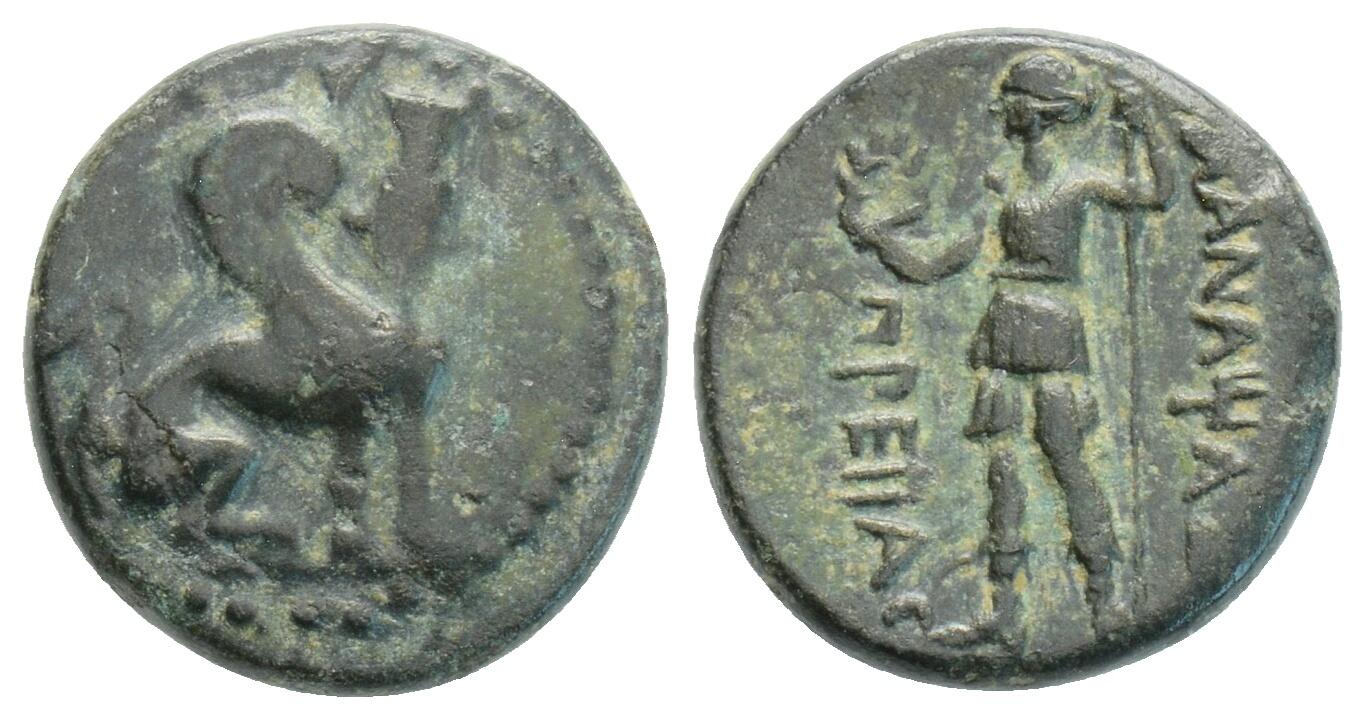S 1855 - Perge, bronze (Sphinx/Artemis) (260-100 BCE)
From SILVER
260 BCE - 100 BCE Bronze
Description
| ObverseInscription or printing placed on the obverse.: | Sphinx seated right, wearing kalathos |
| ReverseInscription or printing placed on the reverse.: | ИANAΨAΣ / ΠPEIIAΣ Artemis standing left, holding wreath and sceptre |
Mint and issuing power
| MintIdentifies the place of manufacture or issue of a numismatic object.: | Perge | Ancient regionAncient region.: | Pamphylia | Modern countryModern country: Turkey | AuthorityIdentifies the issuing power. The authority can be "pretended" when the name or the portrait of X is on the coin but he/she was not the issuing power. It can also be "uncertain" when there is no mention of X on the coin but he/she was the issuing power according to the historical sources: |
Chronology
| FromIdentifies the initial date in a range assigned in a numismatic context. | 260 BCE | toIdentifies the final date in a range assigned in a numismatic context.. | 100 BCE | PeriodTime period of the numismatic object.: Hellenistic 323-30 BC |
Physical description
| MetalThe physical material (usually metal) from which an object is made.: | Bronze |
Median weightMedian of the weights of numismatic objects (in grams). in grams | 3.90 | DenominationTerm indicating the value of a numismatic object. Examples: tetradrachm, chalkous, denarius.: | StandardStandard.: |
Image

S1855 Perge bronze Sphinx Artemis.jpg [1]
References
| Die study referencePublication of the study: | Colin 19961Colin 1996, p. 50-56 | ||
| Coin series referenceReference to coin series study: | Sear II2Sear II, n° 5417 | ||
Obverse dies distribution
Reverse dies distribution
no distribution is available
Quantification
| Number of obversesNumber of obverse dies. ᵖ (o) | 132 | Number of singletons (o1)The number of singleton coins. ᵖ | 94 |
| Number of reverse diesNumber of reverse dies. (r) | 157 | Number of coinsNumber of coins. (n) | 185 |
| Coins per obverse dieNumber of coins per obverse die. (n/o) | 1.4 | Coins per reverse dieNumber of coins per reverse die. (n/r) | 1.18 |
| Reverse per obverse ratioRatio of obverse dies divided by reverse dies. (r/o) | 1.19 | Percentage of singletons (o1)number of coins (n) divided by the number of singletons (o1) ᵖ | 71.21 % |
| Original number of dies (O) (Carter 1983 formula)The estimation of the number of coins according to Carter 1983 ᵖ | 366.74 | Coins struck if 20,000 as average productivity per dieCoins made if the average productivity for obverses (according to Carter) is 20,000. ᵖ | 7,334,800 |
| Original number of dies (O) (Esty 2011 formula)The estimation of the number of coins according to the singleton formula in Esty 2011 ᵖ (O) | 460.75 | Survival rate if 20,000 as average productivity per dieSurvival rate if average productivity is 20,000. ᵖ | 0.00003 |
| Coverage (o = % of O) (Esty 1984 formula)Esty 1984 - coverage (% of O) ᵖ (o = % of O) | 49.19% | Die productivity if survival rate 1/2,000Average productivity if survival rate is 1/2,000. ᵖ | 1,008.89 |
| Weight of silver (in kg) if 20,000 coins per die (O = Carter formula)Carter 1983 * Median weight * 20000 (*10 if gold or electrum) ᵖ | n.a. | Die productivity if survival rate 1/5,000Average productivity if survival rate is 1/5,000. ᵖ | 2,522.22 |
Remarks